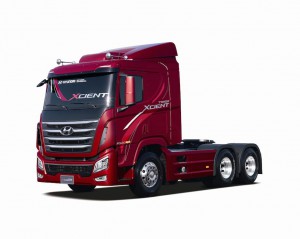Hyundai has had its eye on the truck and commercial vehicle market for a long time and now it’s making its move.
South Korea’s Hyundai Motor Co. announced in Seoul it plans to spend $1.8 billion by 2020 on the development of new commercial vehicles, including entering the race in the United States, to catch up with rivals in a rapidly growing global market, according to Reuters.
In recent years, the commercial vehicle market has been re-shaped by companies, such as Nissan, Ford, Mercedes-Benz, Fiat Chrysler Automobiles and General Motors, that have replaced aging models with new more fuel-efficient vehicles that can fit more easily into heavy urban traffic.
Not only do the new generation of vehicles – often based on designs from Europe where truck builders have faced government and social reform – use less fuel, but also they are also easier to park and service.
Hyundai noted that it sees the demand for commercial vehicles growing by almost 30% in each of the next five years, but its global share hovers around only 2% and its share of the market actually dropped in key markets, such as South Korea and China, as newer entries won over more buyers.
Hyundai said it plans to invest $363.13 million to raise production of vans, trucks and buses in Korea by 2020.
However, the announcement offered no clear indication of whether it plans to enter the pickup truck market in the U.S. Pickup trucks are both commercial and personal use vehicles and Hyundai has been pondering entering the market for the better part of two decades, but has been deterred by the strength of the Ford, Chevrolet and Ram brands that dominate the market and have beaten back challenges from Japanese makers Toyota and Nissan.
Still the pressure from Hyundai dealers in the U.S. to get into the market and pickup carry a huge profit margin the U.S. In addition, the lack of a light-duty truck has put pressure on the company’s marketshare in the U.S. where trucks and utility vehicles account for roughly 54% of all new vehicles sold in 2014, according to Motor Intelligence.
(Hyundai Veloster and Elantra models get big upgrades for 2016. For more, Click Here.)
Hyundai did indicate it plans to build “premium models in North America and Europe,” but provided no other details.
The U.S. is Hyundai’s second-biggest overseas market after China. To launch commercial vehicles there and challenge established rivals will take considerable time, analysts said.
(Click Here for sketches of the new Tucson.)
Hyundai started making its heavy-duty truck Trago Xcient in China last year for the local market, and plans to start building its H350 light commercial vehicle in Turkey in March to enter Western Europe.
Hyundai Motor Group, which spans scores of firms including auto parts maker Hyundai Mobis Co. Ltd., in January said it would spend $73 billion over four years. The announcement followed a government call for conglomerates to spend more to help revive Asia’s fourth-biggest economy.
(To see more about the shake up at Infiniti, Click Here.)
Hyundai’s latest announcement is also likely to be seen part of efforts to alleviate investor complaints about the lack of clarity on a future direction following the automaker’s involvement in an expensive property deal last year.


10 yrs ago I would dismiss this …… not now however !